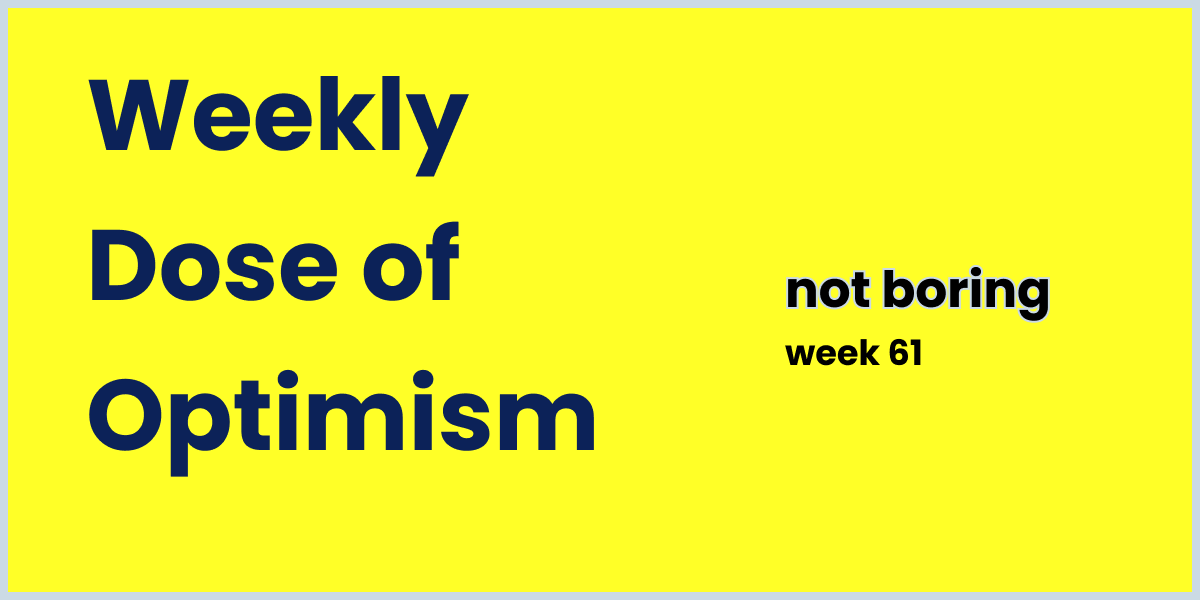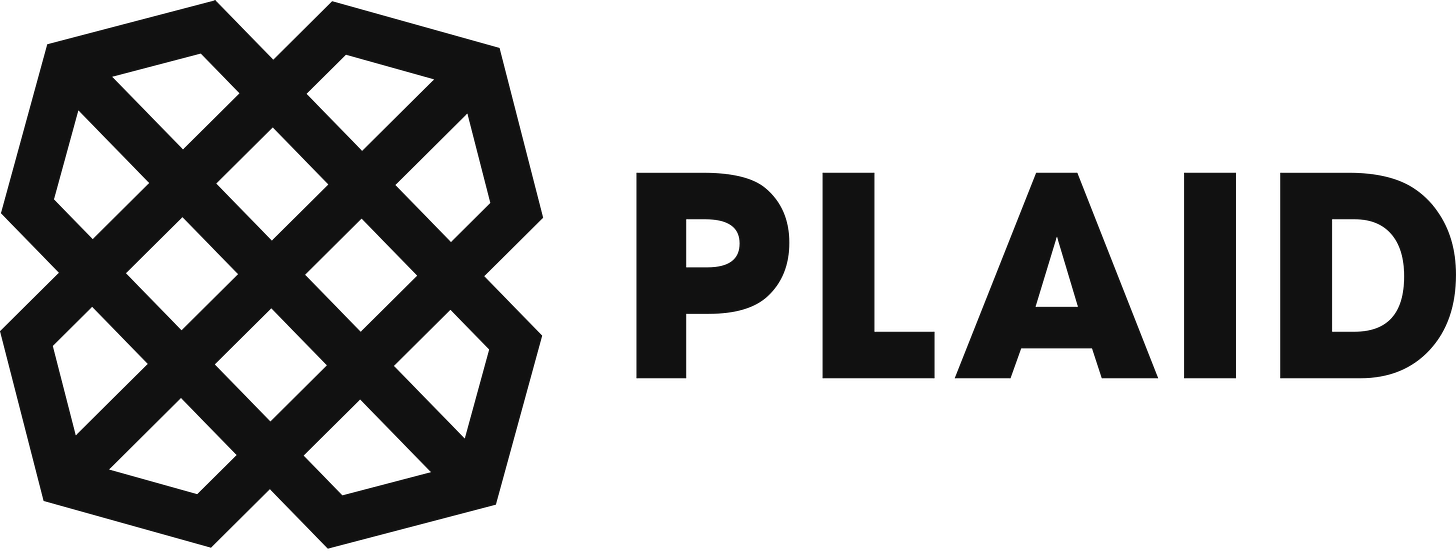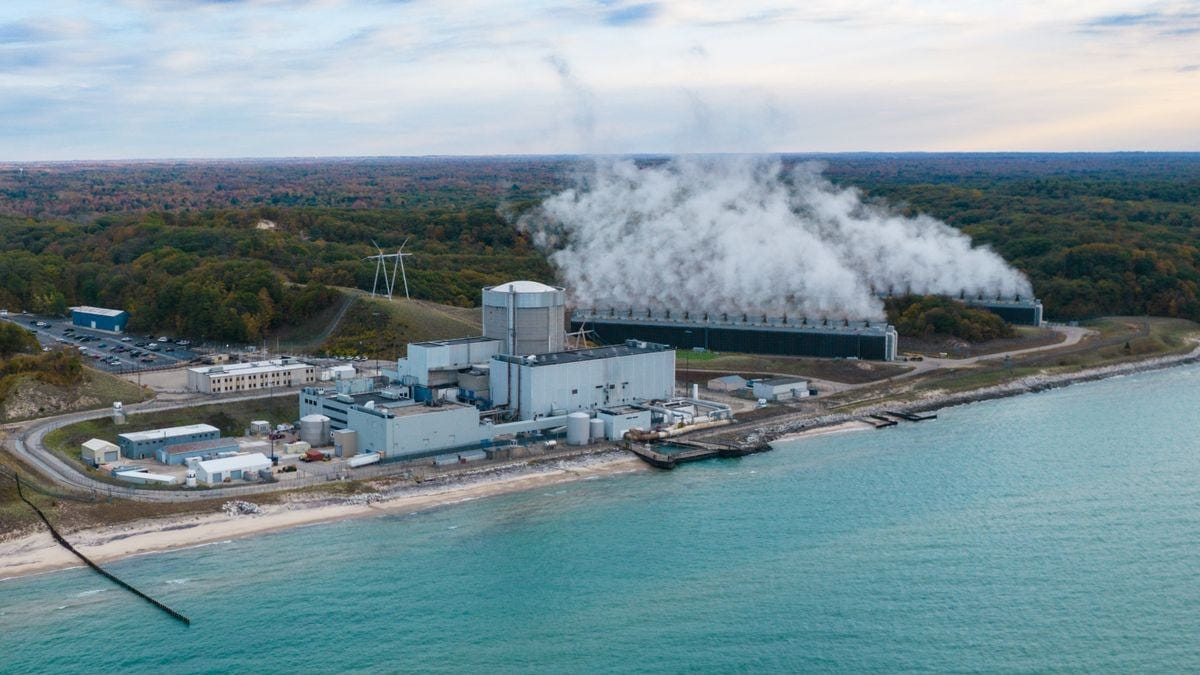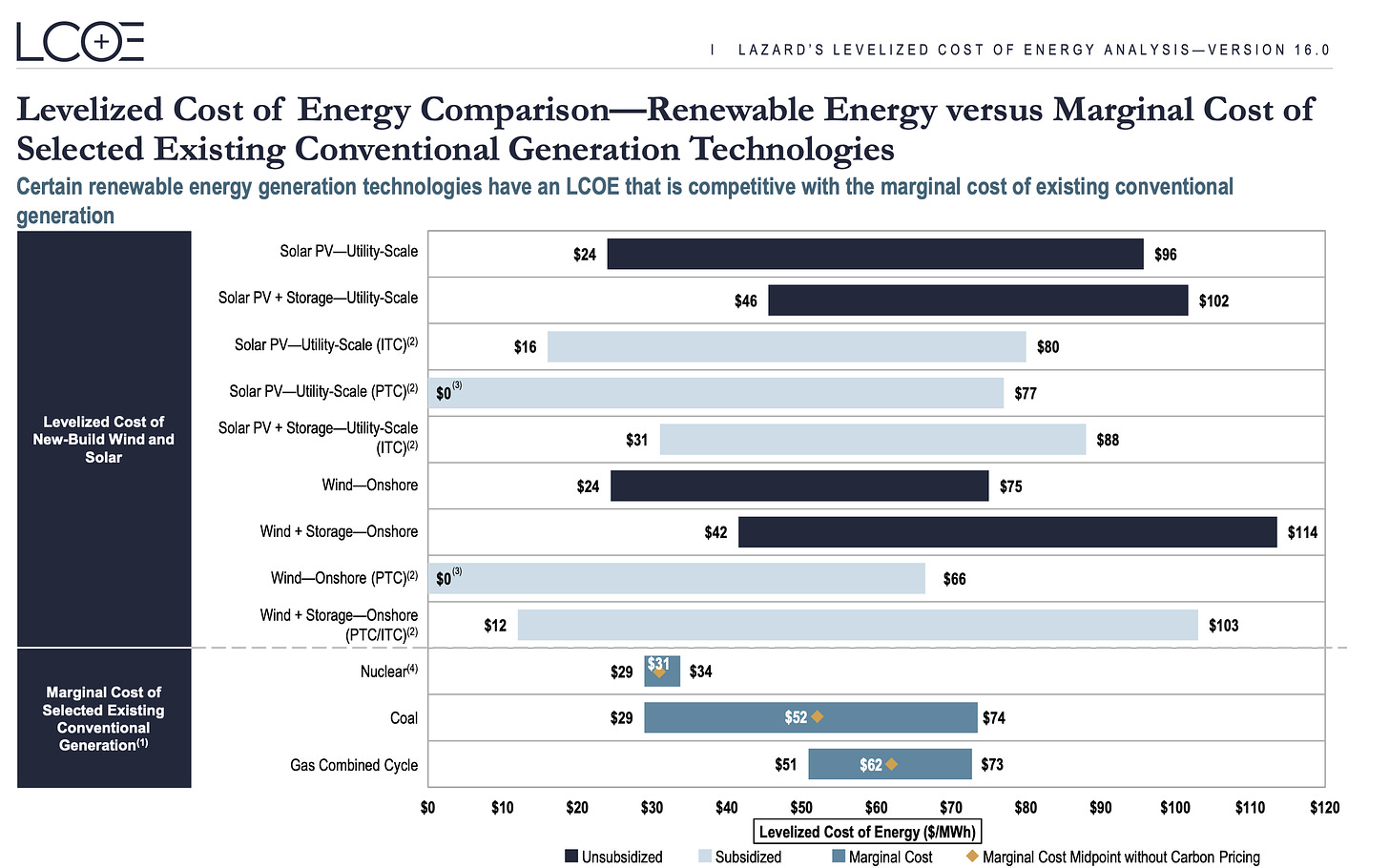

Weekly Dose of Optimism #61
source link: https://www.notboring.co/p/weekly-dose-of-optimism-61
Go to the source link to view the article. You can view the picture content, updated content and better typesetting reading experience. If the link is broken, please click the button below to view the snapshot at that time.

Weekly Dose of Optimism #61
Zuck Clusters, AlphaMissense, Lasker Awards, Permitting Action, Nuclear Re-Opening
Hi friends 👋,
Happy Friday and welcome back to our 61st Weekly Dose of Optimism.
Another exciting week in our world. AI-driven advancements in bioscience, energy action and reform, and some general strong fall vibes.
Let’s get to it.
The Weekly Dose is brought to you by… Plaid
You may know Plaid as the company that easily lets you connect and authorize your bank to your favorite finance apps. When that original product dropped back in 2013, it was like magic and unleashed a whole wave of fintech innovation – think Venmo, Chime, and SoFi. In the decade since, Plaid has established itself as one of the leading fintech infrastructure companies and has rolled out a whole suite of products that allow businesses to get the most out of their financial data - including payments, identity verification, and credit.
The company also has a particularly unique vantage point on the fintech industry. It partners with both cutting-edge startups and legacy incumbents, has experienced the ups and downs of the general macro environment over the last few years, and, as a financial data network, has an inside view of what’s working in fintech today.
Each year, the company publishes its Fintech Spotlight Report. This year’s report, titled “A Focus on Profitability,” covers three main topics: improving profitability, crypto services, and lending. Whether you’re a fintech, lender, banker, investor, or just an interested analyst, you’ll find valuable insights inside the report, which they are making free to download for all Not Boring readers.
(1) Chan Zuckerberg Science To Build AI GPU Cluster To Model Cell Systems
From The Chan Zuckerberg Initiative
“AI is creating new opportunities in biomedicine, and building a high-performance computing cluster dedicated to life science research will accelerate progress on important scientific questions about how our cells work,” said CZI Co-founder and Co-CEO Mark Zuckerberg. “Developing digital models capable of predicting all cell types and cell states from the genome will help researchers better understand our cells and how they behave in health and disease.”
The Zuckaissance (?) continues. The Year of Efficiency. Being in sick shape. Telling Musk to name a time and place. Tripling Meta’s stock price in the last year. And now, allocating what will likely amount to tens of millions of his own wealth towards building a biosciences supercomputer to better understand how cells work.
Applying AI systems to biology has already made significant contributions. DeepMind’s AlphaFold, for example, allows researchers to predict protein structures with a high degree of confidence. But the increasingly complex and GPU-intensive infrastructure needed for this type of work is often cost prohibitive, especially for academic research institutions. The CZI GPU Cluster will be one of the first “to power openly available models of human cells to allow researchers to collaboratively accelerate their work” — meaning Zuck is footing the bill for academic researchers to jam out on these crazy expensive AI models.
CZI’s scientific mission is “to cure, prevent, or manage all diseases.” Big goals. I don’t know how feasible or far off that might be. But the emergence of LLMs in the last year or so, I’d imagine, has accelerated their timelines a bit. And Zuck is not alone here — Google, Microsoft, IBM—all have made big bets on applying AI to the life sciences. That race is heating up. Whoever wins, we all do.
(2) A catalogue of genetic mutations to help pinpoint the cause of diseases
From DeepMind
Today, we’re releasing a catalogue of ‘missense’ mutations where researchers can learn more about what effect they may have. Missense variants are genetic mutations that can affect the function of human proteins. In some cases, they can lead to diseases such as cystic fibrosis, sickle-cell anaemia, or cancer.
The AlphaMissense catalogue was developed using AlphaMissense, our new AI model which classifies missense variants. In a paper published in Science, we show it categorised 89% of all 71 million possible missense variants as either likely pathogenic or likely benign. By contrast, only 0.1% have been confirmed by human experts.
On the way to killing everyone, AI seems hellbent on saving a lot of human lives.
Not to be outdone by Zuck, this week Google’s DeepMind released its AlphaMissense catalogue. Missense variants are genetic mutations impacting the function of human proteins, that can lead to cystic fibrosis, sickle-cell anemia, or cancer. Of the 71 million possible missense variants, AlphaMissense categorized 89% of them as either “likely pathogenic” or “likely benign.” To put that into perspective, human experts have only categorized 0.1% of the variants…so AlphaMissense covered ~890x more ground than human experts.
And it’s important ground! Predicting the effect of variants speeds research and experimentation up significantly. With the information from AlphaMissense, researchers can get a preview of results for thousands of proteins at a time, and gain a better understanding which protein changes lead to diseases.
Just a bad week to be a disease. And a good week to be human.
(3) Advances in Eye Scans and Protein Structure Win 2023 Lasker Awards
Noah Weiland and Cade Metz for The New York Times
The prestigious Lasker Awards were given on Thursday to scientists making advances in the diagnosis of eye disease, the prediction of cellular protein structure and the intricacies of the immune system.
Speaking of DeepMind, the team behind its AlphaFold project was one of three recipients of the prestigious Lasker Awards. The awards highlight fundamental biological discoveries and clinical advances that improve human health, and to draw attention to the importance of public support of science. So we’ll do our part in bringing public attention to the science as well. Here are this year’s three winners:
James G. Fujimoto and his team pioneered optical coherence tomography, a technology that detects eye conditions like macular degeneration and diabetic retinopathy earlier than previous methods, thus preventing blindness. As the dog parents of a pooch who suffered from macular generation, we support Fujimoto & Co’s work.
Demis Hassabis, John Jumper, and other DeepMind researchers developed AlphaFold, an A.I. system capable of predicting the 3D shape of proteins from their amino acid sequences in minutes, revolutionizing protein research.
Dr. Piet Borst made significant discoveries regarding the adaptability of parasitic diseases to evade immune defenses and identified how certain chemotherapy drugs are barred from the brain and body by transport proteins.
Notably, winners of the Lasker Awards often go on to win a Nobel Prize, so be on the lookout for these three groups in October when Nobel announces its next class of prize winners. But don’t worry, y’all are winners already in our eyes!
From The White House
Department of Transportation and Department of Commerce Adopt New Tools for EV Charging, CHIPS Manufacturing Through Bipartisan Permitting Reforms
Last week, we covered Derek Thompson and Brian Potter’s conversation on why building is so slow in America these days. We concluded that regulation currently outpaces building technology. We basically wrote off fixing regulation because, well, we don’t have a great track record there.
Biden’s team must read The Weekly Dose because earlier this week the Administration issued an executive action to accelerate permitting. The executive action mainly focuses on two agencies, the Department of Transportation and the Department of Commerce, because those two agencies have oversight over two of Biden’s major strategic priorities: clean energy and chips manufacturing.
The Department of Transportation is excluding electric vehicle charging stations from NEPA environmental reviews. In plain English, this will make constructing new EV charging stations much less of headache, which will mean more charging stations, which will pull forward demand for EVs, which furthers Biden’s clean energy agenda.
The Department of Commerce is accepting 11 “categorical exclusions” to help expedite review for semiconductor manufacturing projects. The new semiconductor fab projects have been hamstrung by a number of issues, including permitting and other related regulations. The goal in adopting these exclusions is to expedite the environmental review of these fab builds, and not slowing down what the Administration has clearly deemed a matter of national security.
So perhaps we were a bit pessimistic last week. Permitting reform is possible when the reform directly aligns with the strategic priorities of the sitting President during an election cycle.
(5) Restart of Palisades nuclear plant takes ‘giant step’ as Holtec, Wolverine Power sign PPA
Larry Pearl for Utility Dive
The Palisades nuclear plant closed in May 2022 due to tough financial conditions and was then acquired by Holtec in June 2022. According to Holtec, this would be the first time a shuttered nuclear plant has successfully restarted in the U.S.
Packy here. There are currently 93 active nuclear reactors operating at 54 power plants across the United States, 11 fewer than were operating a decade ago. Since 2012, 12 nuclear power plants have permanently closed and another seven are scheduled to close up shop by 2025. Palisades, an 800-MW plant in Michigan, is one of the 12 shutdowns… but it may be coming back to life.
Palisades may be the first nuclear plant to reopen after shutting down and giving up its license in US history.
Holtec, which bought the plant from former owner Entergy in 2022 in order to decommission it, announced a power purchase agreement (PPA) with Wolverine Power Cooperative and Hoosier Energy, which will go into effect once the plant is up and running again in late 2025 or early 2026.
While nuclear plants can be expensive to build, power from existing nuclear plants is among the cheapest, cleanest, and firmest sources of electricity available at $31/MWh, according to Lazard. Keeping nuclear is cheaper than adding new renewable capacity in many cases.
Holtec’s decision to restart Palisades was spurred by a $6 billion federal initiative to prolong nuclear facilities, and it’s applying for roughly $1 billion in federal loans from the Department of Energy’s Loan Program Office. The company is also seeking $300 million from the state.
If Holtec is successful in opening Palisades back up, it could set a path for other shuttered US plants, and for German plants that have been closed only to be replaced by coal. It also seems to be a positive example of operators working constructively with the Nuclear Regulatory Commission (NRC) and government to support clean baseload power and jobs.
That’s all for this week. If you have some time this weekend, check out Plaid’s 2023 Fintech report.
We’ll be back in your inbox on Tuesday.
Thanks for reading,
Dan + Packy
Recommend
About Joyk
Aggregate valuable and interesting links.
Joyk means Joy of geeK




